In navigating the line between professional and unprofessional, email addresses have an important role to play. Just think of how you regard a person differently if they email you from a [email protected] email address versus if it comes from [email protected]?
Whether or not it seems fair to you, if you want to be taken seriously professionally, having a professional email address matters. And if you run a business (even if it’s a one-person business), then you need one that matches the domain name of your website.
Why Having a Branded Email For Your Business is Important
If you’re still skeptical about the importance of a branded email address, there are a few main reasons to re-think your position.
1. It makes you look more professional.
This is the most important reason on the list. If you want people to take your business seriously, one of the best things you can do is create a business website and an email address to match. It shows people that you’re not just someone dabbling; you take what you do seriously.
In a world full of scammers, knowing you have a legit website and email address sets you apart and lets potential customers know you’re trustworthy.
2. It makes it clear who the email is coming from.
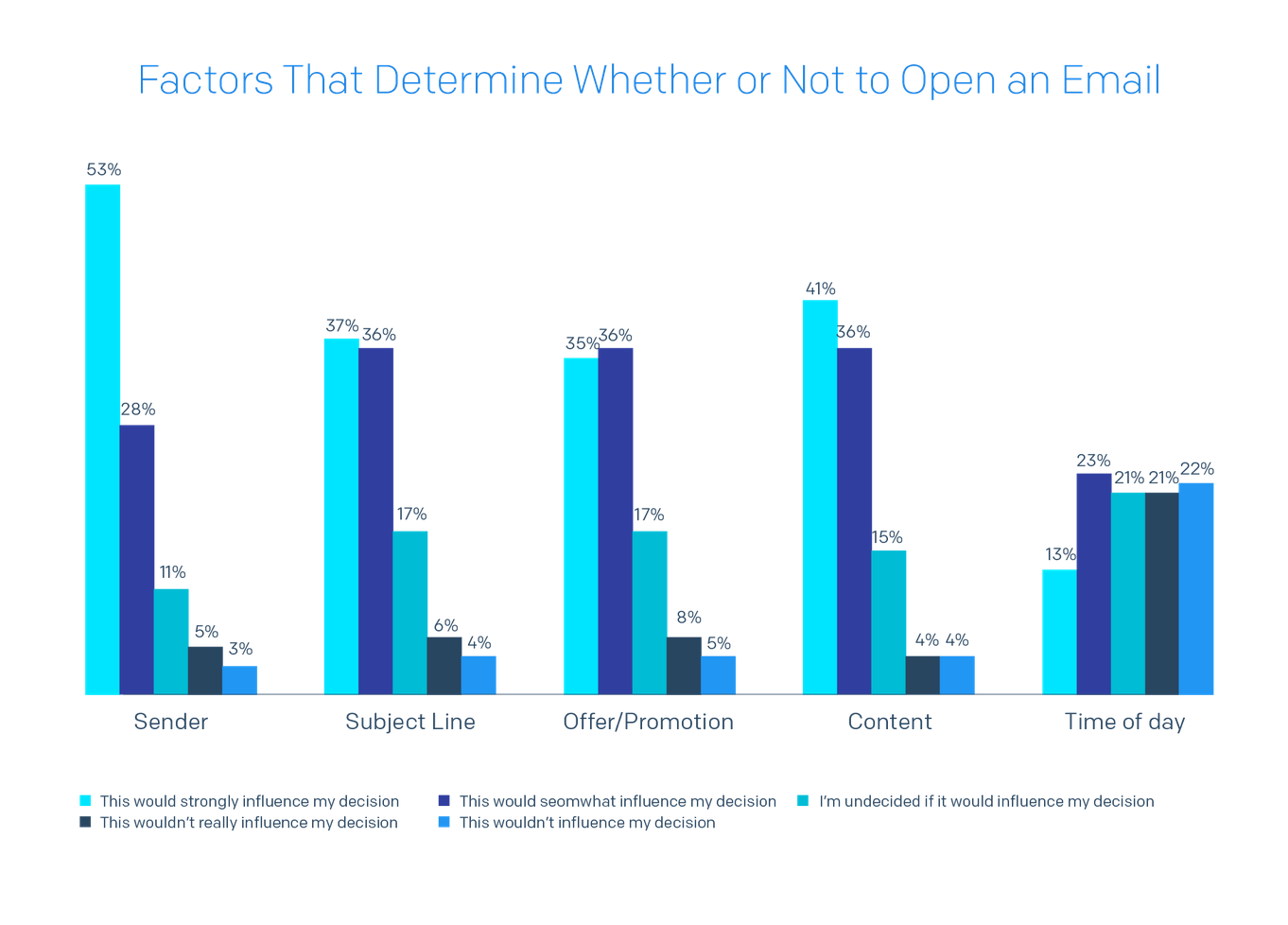
If your email address in no way resembles your business name, people will have a hard time connecting the two. According to SendGrid’s 2019 email benchmark survey, the biggest factor people say “strongly influences” whether they’ll open an email is who the sender is.
Your recipients are more likely to write you off as a stranger and ignore your email if they don’t know to associate the unfamiliar email address with the business they have a relationship with.
For all the effort marketers put into crafting the perfect subject line and email copy, having an email address people recognize and trust is the best way to stand out in a recipient’s inbox.
3. It lets people know where to find your business website.
As an added bonus, if someone who receives your email is interested in learning more about your business, they can see the domain name embedded within the email itself. It’s easy to figure out where to go to get more information on what you sell.
Anything that drives more traffic to your website can’t be discounted—a website visit is often a step in deciding to hire someone or make a purchase.
How to Set Up a Branded Email Address
Now that you know you need your own branded email address, how can you make it happen?
Step 1: Invest in a web hosting account.
If you already have a business website, this step is already complete. If not, it’s an important prerequisite to having both a website and a personalized email that matches the domain name.
Many hosting plans (including those offered by Virtue Media) come with free email addresses – sometimes even an unlimited number of them. If yours doesn’t, consider switching to one that does.
Step 2: Decide on a naming convention.
If you have a one-person business, this might not seem important now, but if your business ever grows, you’ll want consistency. Try one of the following traditional formats:
Whatever you choose now, it will be easier for customers down the line to know how to contact you and your employees if you stick with it.
Step 3: Create your email account.
How this step works will vary depending on the web hosting provider you use. If you don’t have Virtue Media, check the support articles on your provider’s website for step-by-step instructions.
For Virtue Media customers, set up your email account in cPanel:
You can watch this video tutorial on how to create an email address, or follow these instructions:
- Sign into your cPanel account.
- Scroll down to the Email section, and click Email Accounts.
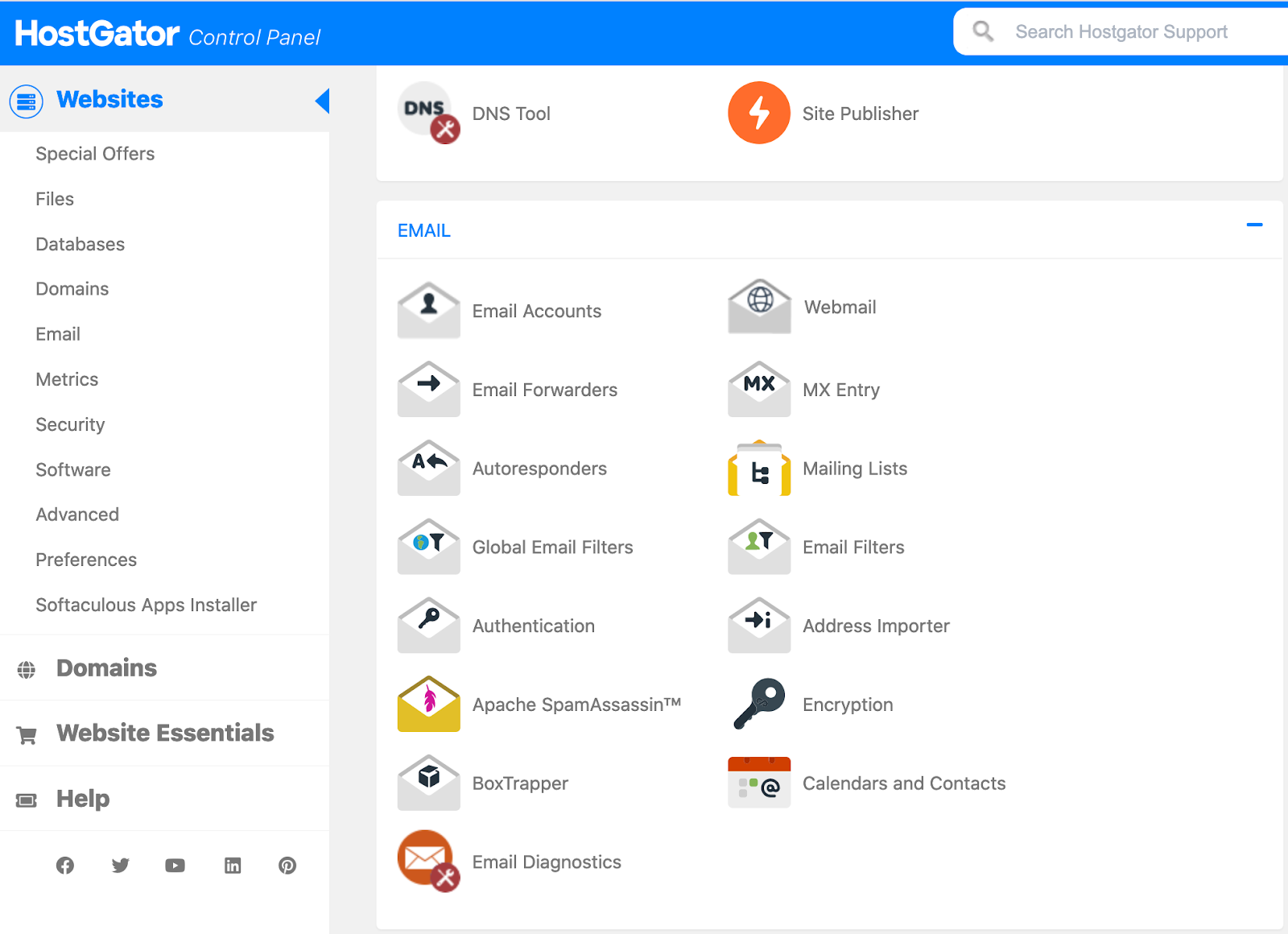
- Fill in the Email field with your new email name, based on the naming convention you chose.
- Then fill in the password fields with a secure password (so, not 123456). You can see how strong the password is in the Strength bar below the password fields. If you need help coming up with something secure enough, use Virtue Media’s password generator.
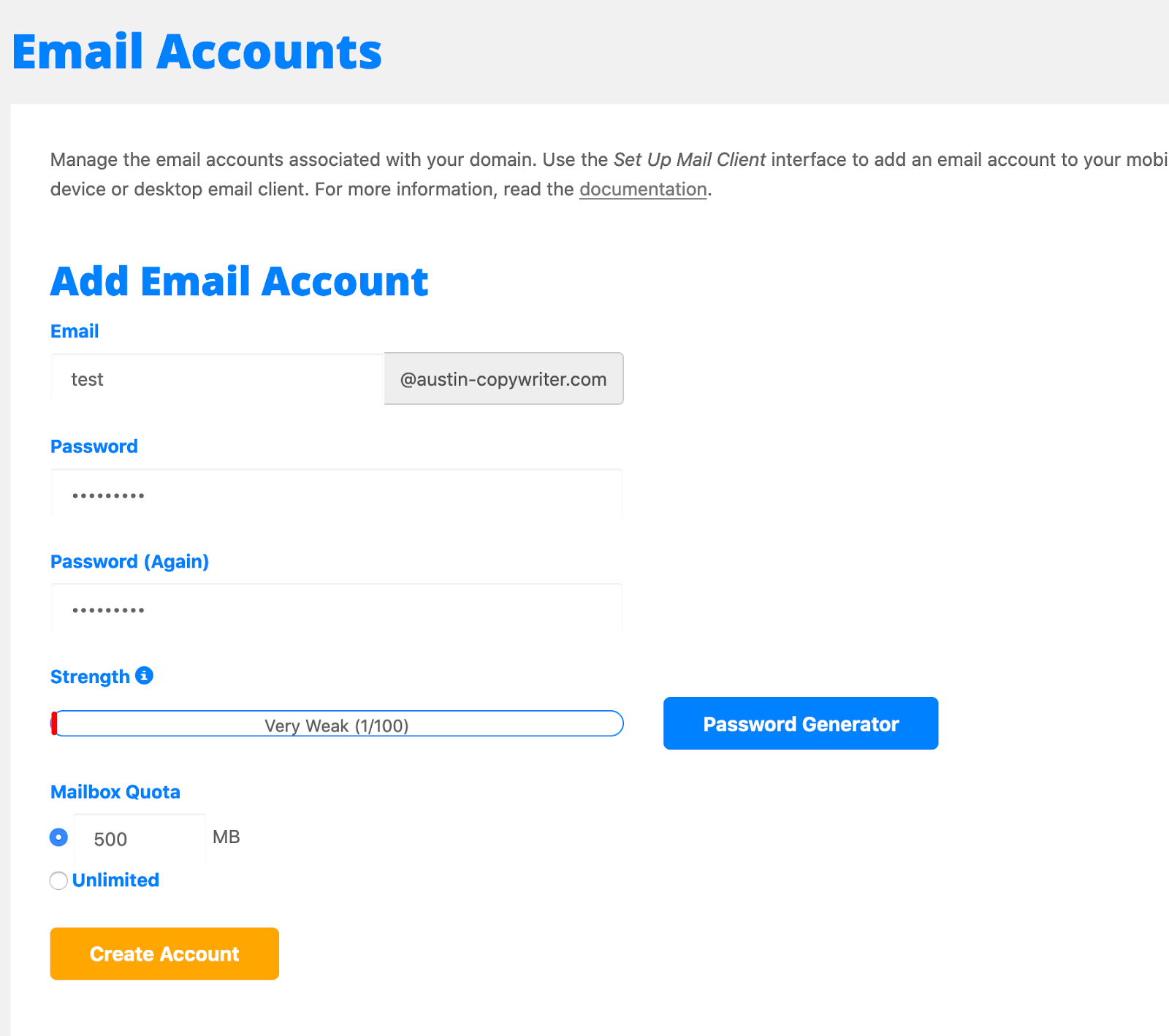
- Click the orange Create Account button.
Congratulations! Now you officially have a branded email address.
Step 4: Choose and set up your email client.
While you can create a branded email address in cPanel, it doesn’t provide the functionality you need to use the email address. Namely, the ability to send and receive emails, as well as useful features like setting up an email signature or creating folders in your inbox to organize your communications.
To do all that, you want to choose an email client. Even if you’re not familiar with the term “email client”, you’re likely familiar with some of the most common examples: Outlook, MacMail, Thunderbird, and Gmail.
While all of those email clients provide features that give you more control over the process of writing, receiving, and organizing your email account, Gmail is a popular choice for businesses for a few compelling reasons.
While it does require a monthly fee, investing in G Suite comes with a number of tools besides Gmail that enable you to do work and collaborate more effectively with a team
That includes:
- Google Calendar – A calendar tool you can use to organize your own schedule, and to create shared calendars that anyone on your team can access, as well as calendar invites that make it easy for others to add events to their own calendar.
- Google Drive – The main space for organizing all the files you create in other Google programs.
- Google Slides – A tool for creating presentations, which includes the option for multiple people on a team to access, update, edit, and comment on the same presentation for efficient collaboration.
- Google Docs – A word processing program that, as with Slides, allows as many people as you choose to collaborate on a shared document.
- Google Sheets – Google’s spreadsheet program, that provides the same collaboration options as Slides and Docs.
- Google Meet – A program for setting up and hosting virtual meetings
G Suite is a powerful suite of tools for anyone running a business. And because they’re all part of one package, the tools all work together seamlessly.
How to set up your email in G Suite with Virtue Media:
If G Suite sounds right for you, you can order and get it set up within your Virtue Media account:
- Log into your Customer Portal.
- Select Email & Office from the menu on the left side of the screen.
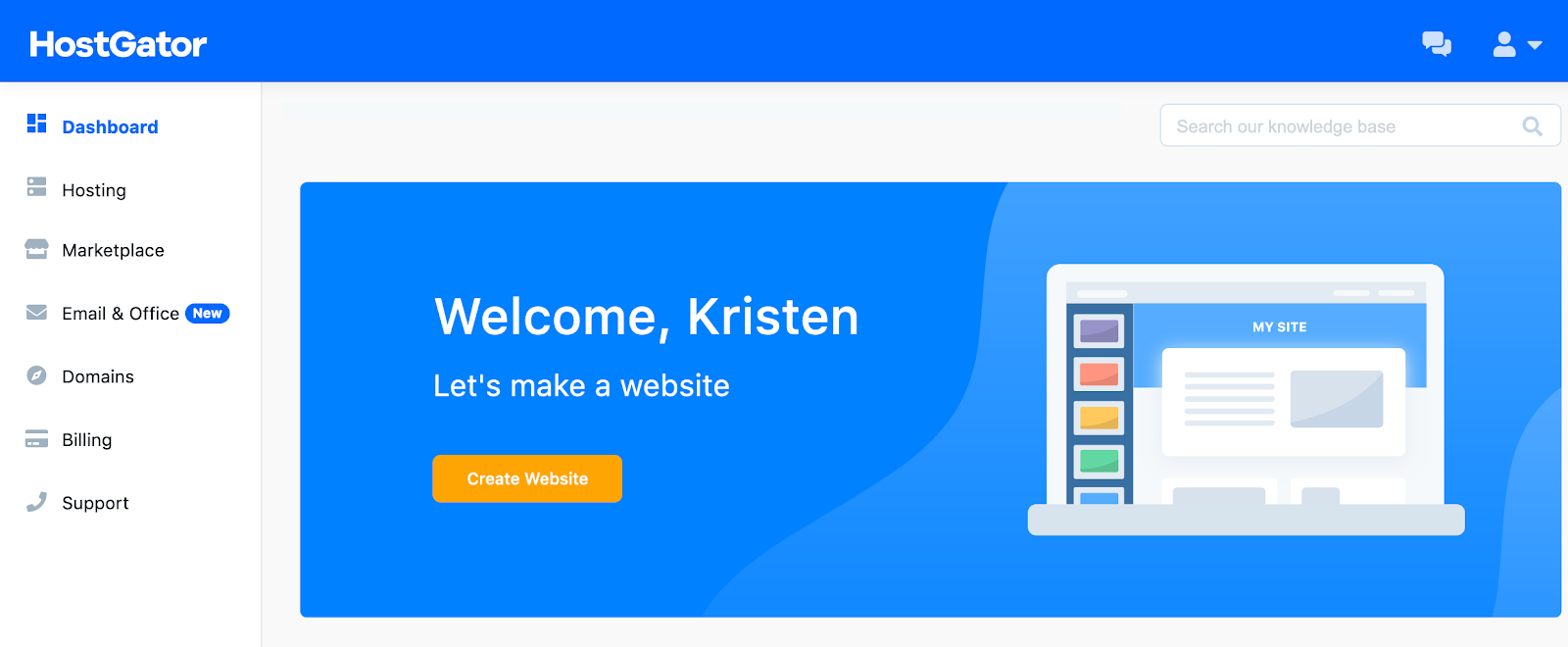
- Click See Details in the G Suite box.
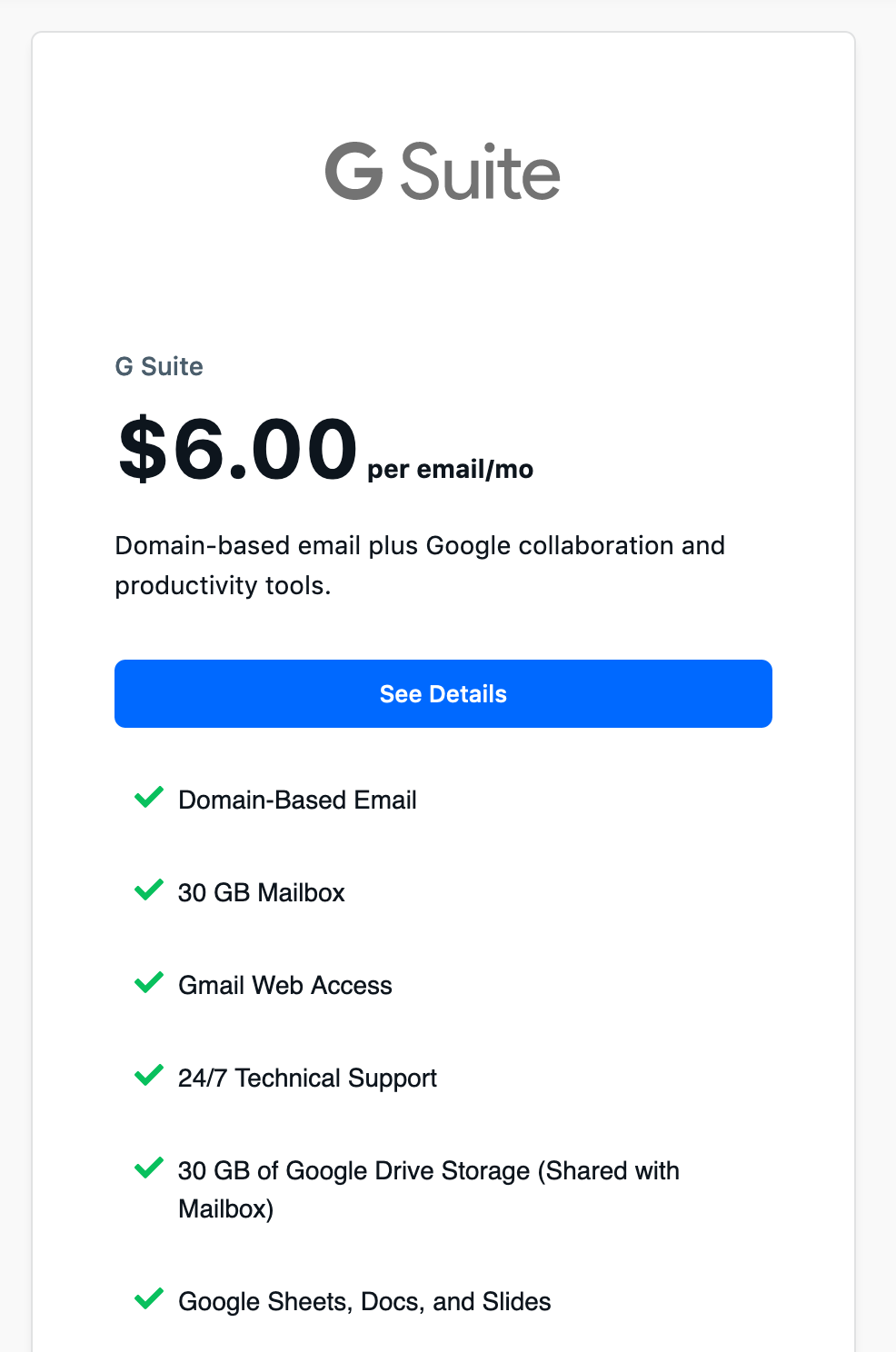
- Choose Buy Now and provide your payment information to complete the purchase.
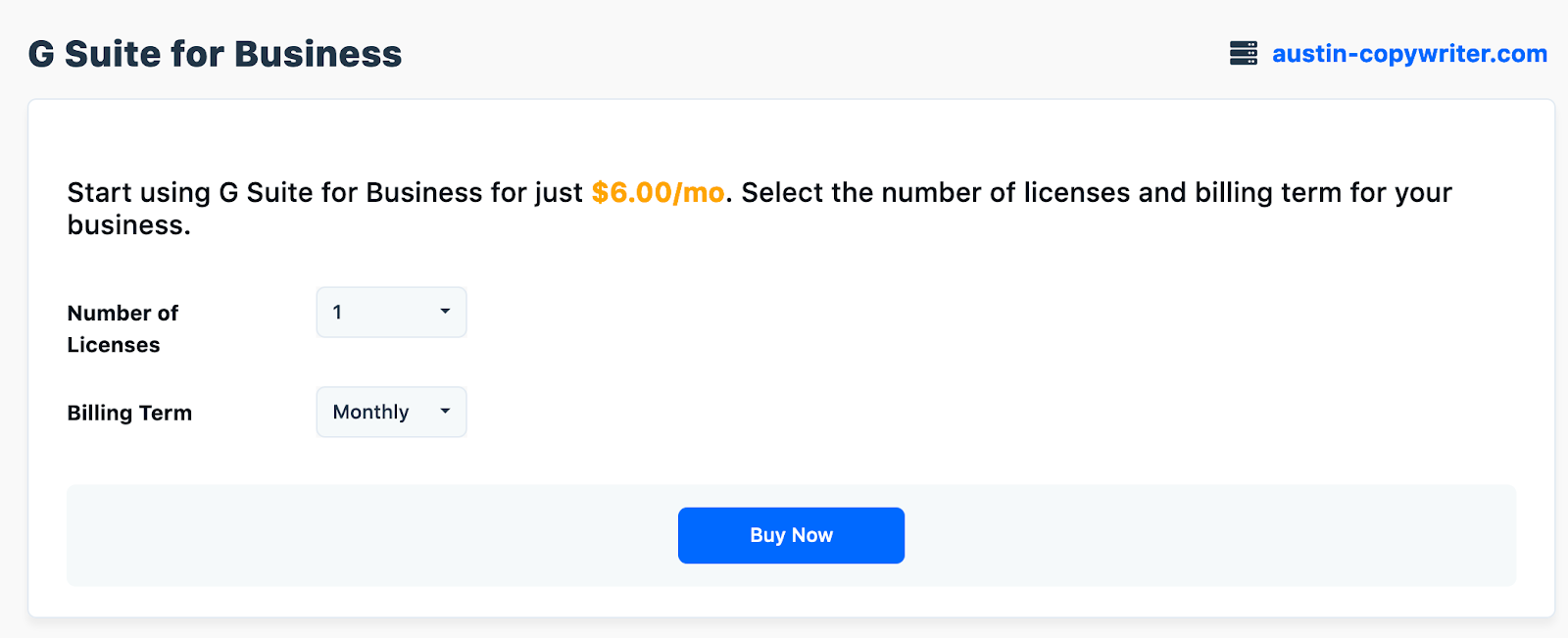
- Once your purchase is made, access G Suite by choosing Marketplace in the left-side menu of your Control Panel (right above Email and Office).
- Find G Suite in the list of programs, and click Manage.
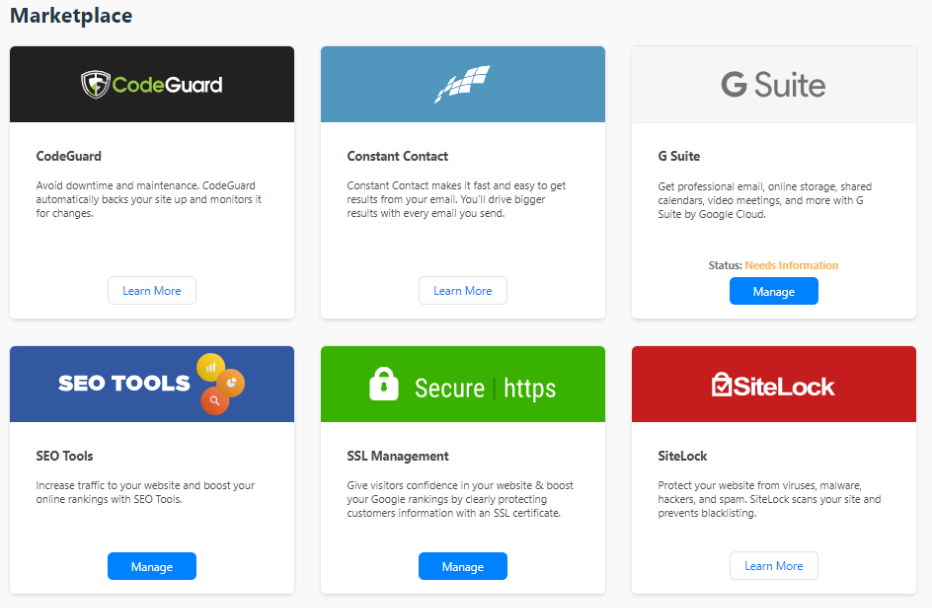
- The first time you open G Suite after purchasing, you’ll be prompted to fill in your administrator information, including selecting what domain your G Suite subscription is for.
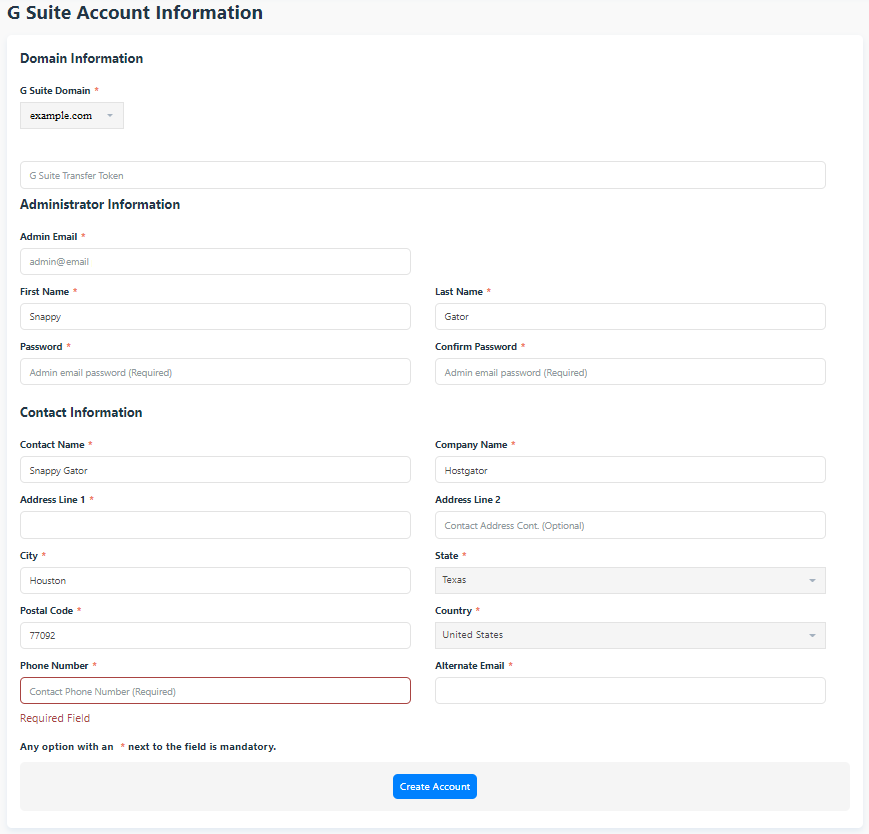
- Now, you can start working within the G Suite program itself. Go to admin.google.com, and log in with the information you provided when setting up your account.
Google has created helpful resources for anyone getting started with the program. Spend a little time familiarizing yourself with the tools now available to you.
Note: If you chose another email client, or if you already had a G Suite subscription independent from your Virtue Media account, you can find specific instructions for getting set up with each email client here. If you’re not a Virtue Media customer, check the resources your domain registrar provides for instructions.
Step 5: Personalize how your email appears in inboxes.
You’ve probably noticed that most of the emails that show up in your inbox don’t show an email address in the sender’s field, they show up as a person’s name (or in some cases a business function, like Support or Billing). That’s because people took the time to add their name, and often their headshot, to their business email account to personalize it more.
As a communications medium, email can sometimes feel less personal than others. By adding your name and photo, you can make it easier for people to see the human behind the email.
- To do this in Gmail, click on the G Suite icon in the top right corner of your inbox.
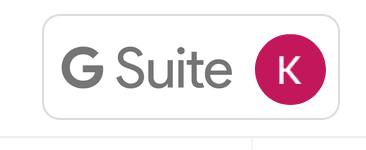
- Click on Manage Your Google Account.
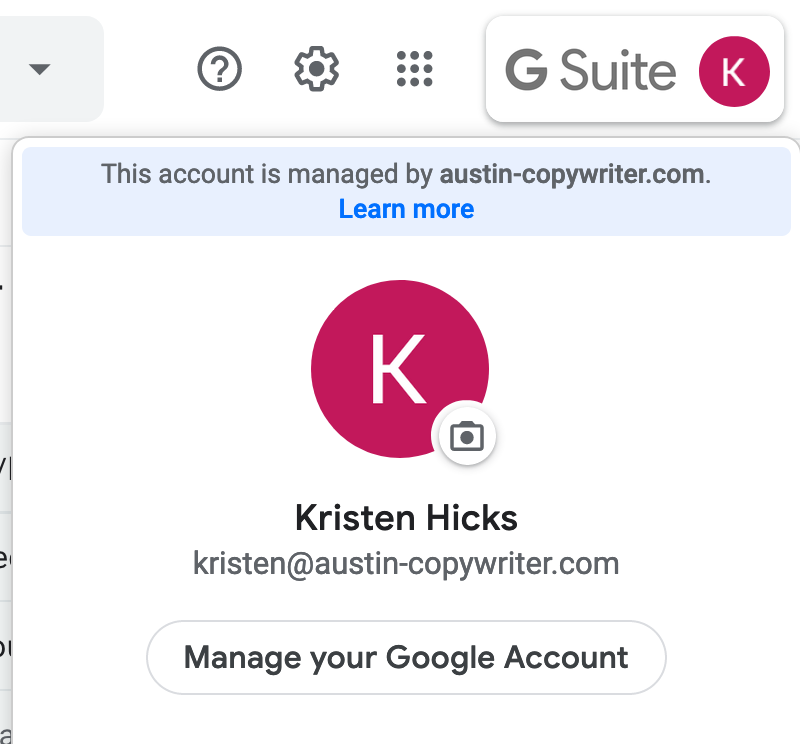
- Click on Personal Info in the left-side menu.
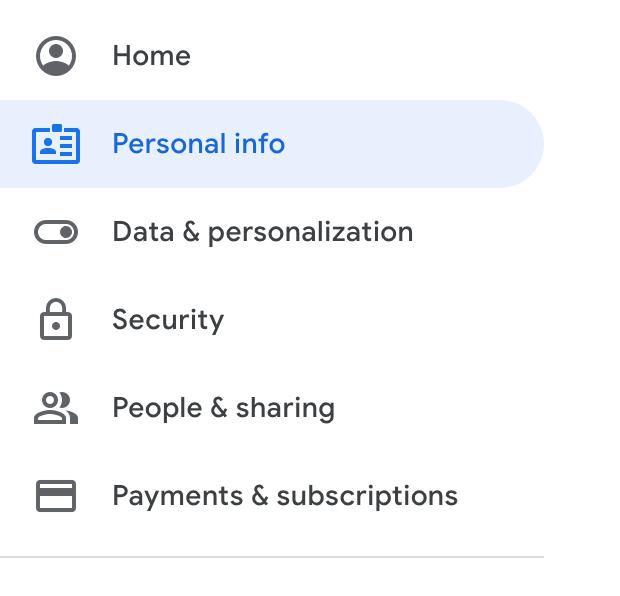
- To add a photo, click where it says Add a photo to personalize your account, and load the file of your favorite headshot when prompted.
- To add your name, click on the field that says Name and type it in.
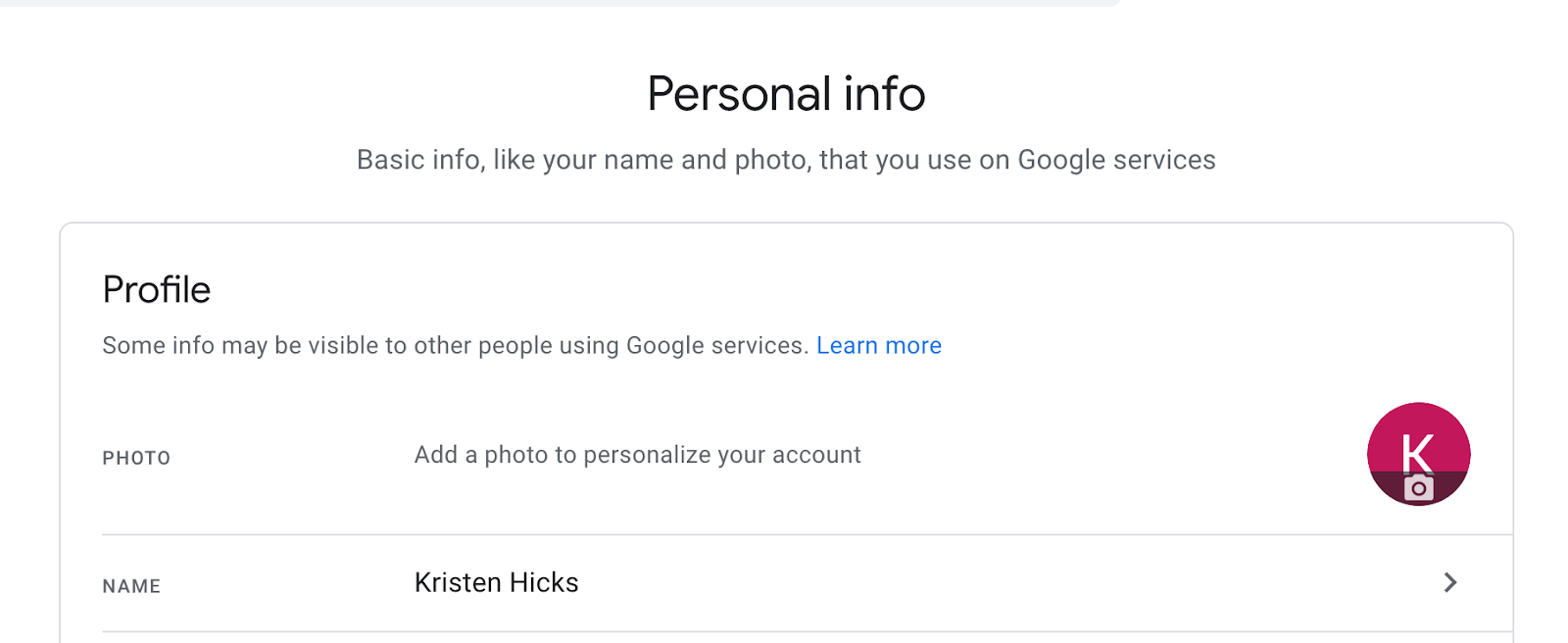
How to Use Your New Business Email Well
Now you’ve got your professional, personalized email address set up and ready to go.
But having a professional-looking email address isn’t enough to ensure you always look professional in your emails. There are a few other tips you should follow to gain the respect of the people you communicate with and keep your professional relationships positive.
1. Have a clear signature.
A signature makes it easy for anyone you correspond with to figure out how to contact you if they need to do so through some means other than email. It’s a nice courtesy for them and gives you a chance to do some additional branding, since you can include a link back to your business.
A signature looks something like:
Suzy Lastname
Owner and CEO
Suzy’s Business Name
suzysbusiness.com
555-555-5555
And if you want, you can tack a social profile or two to the bottom to encourage more people to follow you, or add a message about something important to your business like “We’re hiring! Find out more at <link>”
2. Never email angry.
One of the nice benefits of email in comparison to other forms of communication is that you’re never put on the spot. Anytime you’re in an emotional state where you’re tempted to say something unprofessional you might regret later, you can always close the window or step away from the computer for a bit. Wait to send business emails until you’ve had a chance to cool down and think through the best way to communicate what you want to say.
3. Read over all your emails.
Typos happen to everyone, but they can quickly make an email that seems clear to you become incomprehensible to the recipient. Read over each email before you send it to make sure that you haven’t made any embarrassing errors and that what you’re trying to say is clear. You’ll be amazed at all the little mistakes you catch when you do this.
4. Don’t be a spammer.
Anyone who uses email professionally needs to be careful about this. If you’re not, your domain name could be blacklisted so that all your emails get caught in spam filters rather than reaching their recipients.
The most important way to avoid being a spammer is to keep an opt-in philosophy: only send marketing emails to people who have already said it’s okay to do so. When you send out mass emails, make sure to use an email marketing software like Constant Contact (note: Virtue Media customers that subscribe to Constant Contact through Virtue Media can enjoy an extended free trial).
And avoid all the tricks you see used in the emails in your own spam folder, like deceptive subject lines, misleading claims, or the overuse of language associated with pushy salesmen like “free” and “prize.”
Having a personalized email that matches your domain name is an important step in showing your potential customers that you’re serious, but from there you still have to run your business and email account in the right way to keep up that professionalism. Following a few email marketing best practices can ensure your business email account stays on the up and up and represents the business well.



![How to Create Your Freelance Brand [5-Step Guide]](https://mdvirtue.com/wp-content/uploads/2022/02/How-to-Create-Your-Freelance-Brand-5-Step-Guide-400x250.jpeg)
![How to Build a Coaching Website on WordPress [Expert Guide]](https://mdvirtue.com/wp-content/uploads/2022/02/How-to-Build-a-Coaching-Website-on-WordPress-Expert-Guide-400x250.jpeg)

0 Comments